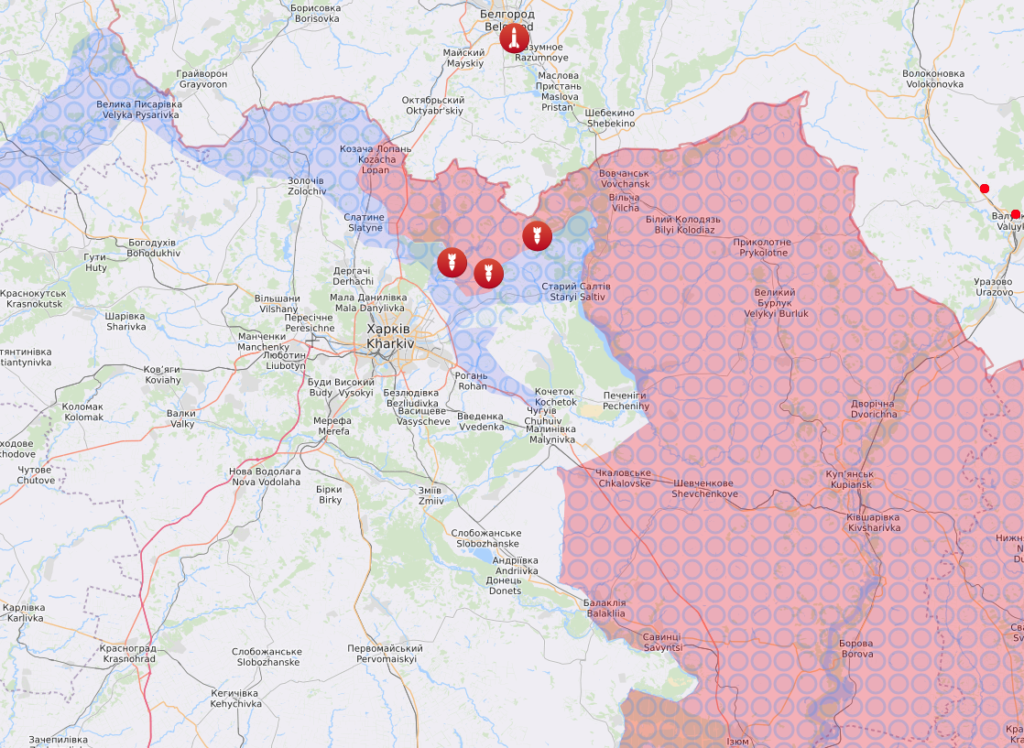Ukraine appears to have won a decisive victory by driving Russian forces from the second largest city of Kharkiv and is now pushing them all the way back to the Russian border.

The Russian military has likely decided to withdraw fully from its positions around Kharkiv City in the face of Ukrainian counteroffensives and the limited availability of reinforcements. Russian units have generally not attempted to hold ground against counterattacking Ukrainian forces over the past several days, with a few exceptions. Reports from Western officials and a video from an officer of the Donetsk People’s Republic (DNR) indicate that Moscow is focused on conducting an orderly withdrawal and prioritizing getting Russians back home before allowing proxy forces to enter Russia rather than trying to hold its positions near the city.
Ukraine thus appears to have won the Battle of Kharkiv. Ukrainian forces prevented Russian troops from encircling, let alone seizing Kharkiv, and then expelled them from around the city, as they did to Russian forces attempting to seize Kyiv. Ukrainian forces will likely attempt to disrupt at least the westernmost of the ground lines of communication (GLOCs) between Belgorod and Russian forces concentrated around Izyum, although Russia is using several GLOCs, including some further away from current Ukrainian positions than any Ukrainian counteroffensive is likely to reach soon. The terrain east of current Ukrainian positions may also favor the Russians attempting to defend their GLOCs, as large water features canalize movement and create chokepoints that the Ukrainians would have to breakthrough.
Russian troops continued efforts to advance all along the periphery of the Izyum-Donetsk city salient but made little progress. Russian forces attempted a ground offensive from Izyum that made no progress. We had previously hypothesized that Russia might give up on attempts to advance from Izyum, but the Russians have either not made such a decision or have not fully committed to it yet. Small-scale and unsuccessful attacks on the southern end of the salient near Donetsk City continued but made no real progress.
The main Russian effort continues to be the attempt to encircle Severodonetsk and Lysychansk from the north and from the south. Russian troops attacking from Popasna to the north made no significant progress in the last 24 hours. Russian forces coming north-to-south have failed to cross the Siverskyi Donets River and taken devastating losses in their attempts. The Russians may not have enough additional fresh combat power to offset those losses and continue the offensive on a large enough scale to complete the encirclement, although they will likely continue to try to do so.
Yeah, about that river crossing. There’s an awful lot of post-battle evidence that was an absolute disaster.
Attempting to cross a river near Bilohorivka, east of Lyman, a Russian mechanized battalion got blasted out of existence by Ukrainian artillery:
The better part of a Russian army battalion — 50 or so vehicles and up to a thousand troops — in recent days tried to cross a pontoon bridge spanning the Siverskyi Donets River, running west to east between the separatist provinces of Donetsk and Luhansk in eastern Ukraine.
Ukrainian artillery caught them at the river bank — and destroyed them. The rapid destruction of around three dozen tanks and other armored vehicles, along with the bridge itself, underscores Russia’s deepening woes as its troops try, and fail, to make meaningful gains in eastern Ukraine’s Donbas region.
“We still assess Russian ground force in the Donbas to be slow and uneven,” an unnamed U.S. Defense Department official told reporters on Tuesday. The Russians’ inability to cross rivers might explain their sloth.
The Siverskyi Donets, which threads from southern Russia into eastern Ukraine then back into Russia, is just one of several water barriers Russian battalions must cross in order to advance west into Ukrainian-held territory. According to the Ukrainian armed forces’ general staff, the battalion that got caught at the pontoon bridge apparently was trying to strike at Lyman, a city of 20,000 that lies 17 miles west of the doomed crossing.
The Ukrainian army’s 17th Tank Brigade spotted the bridge, perhaps using one of the many small drones that function as the army’s eyes over the battlefield. The 17th is one of the army’s four active tank brigades. Its line battalions operate T-64 tanks and BMP fighting vehicles. But it was the brigade’s artillery battalion with its 2S1 122-millimeter howitzers that apparently got first crack at the Russian bridge.
The 17th’s shelling destroyed at least seven T-72 and T-80 tanks, 17 BMPs, seven MT-LB armored tractors, five other vehicles and much of the bridging unit itself, including a tugboat and the pontoon span.
It’s unclear how many Russians died or were wounded, but it’s worth noting that no battalion can lose three-quarters of its vehicles and remain capable of operations. In one strike, the Ukrainians removed from the battlefield one of the roughly 99 Russian battalion tactical groups in Ukraine.
Proving that some people (or institutions) don’t learn from their mistakes, Russia compounded their disasterous stupidity by trying the exact same thing again, with the same results.
Russia has made another failed attempt to cross a Donbas river where an entire battalion was wiped out by Ukrainian artillery – losing more men in the process with survivors forced to swim to safety.
Putin’s troops were trying to rescue men and vehicles that had got stranded on the wrong side of the Donets River, near Biolhorivka, after the first attempt on May 8 ended with their pontoon bridges being sunk by an artillery barrage that destroyed dozens of armoured vehicles and may have killed more than 1,000 troops.
But their rescue mission was found out and subjected to the same fate. Fresh satellite images taken near Biolhorivka show yet another sunken pontoon bridge along with half a dozen destroyed or abandoned vehicles.
Russia has lost more than 70 vehicles and seen two infantry battalions mangled in four days of attempts to bridge the river.
Here’s some decent drone footage of the aftermath:
Conducting a river crossing under enemy fire has always been a difficult undertaking, which is why Clausewitz devoted two chapters to the topic. Even the most basic combined-arms operations are difficult to carry out under the best of circumstances. Difficult operations become impossible ones if you’re stupid.
